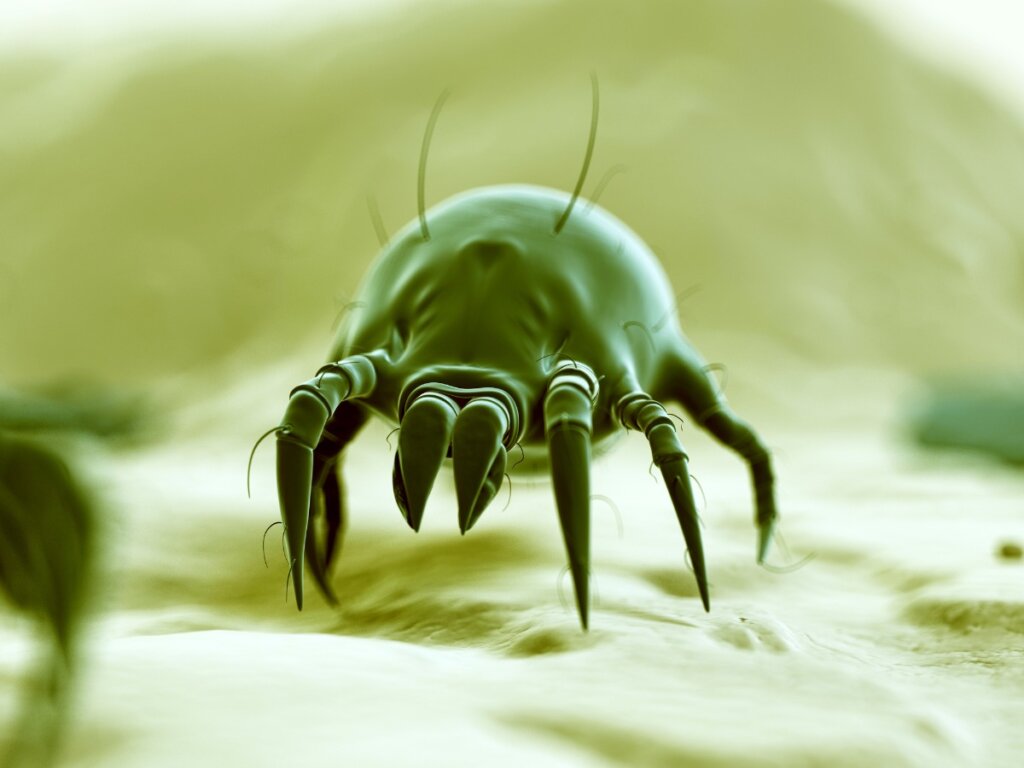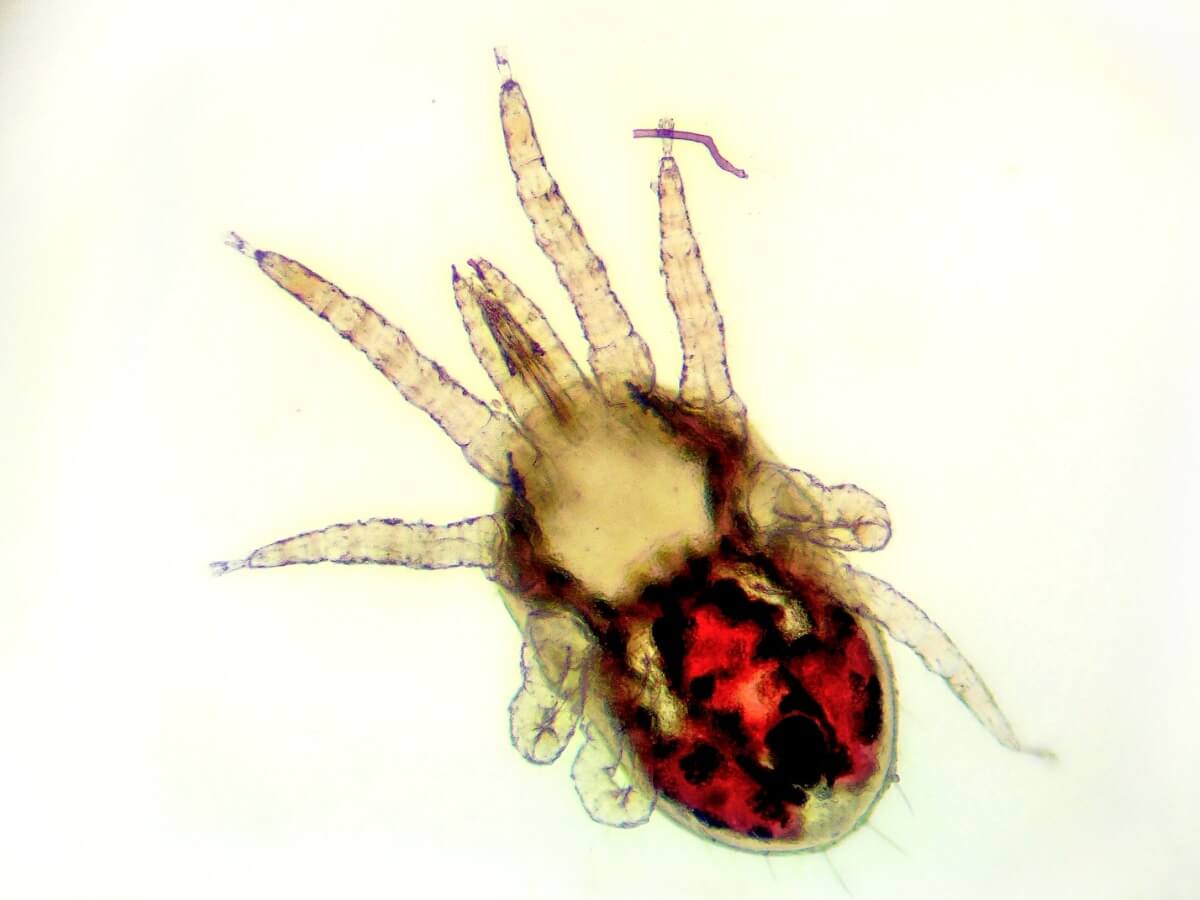10 Curiosities About Mites

Sometimes the largest groups of living things in terms of biodiversity are hidden from our eyes. Beyond the human senses, there are a series of microscopic animals essential for our ecosystems. They have multiple tasks, from degrading organic matter in the environment to parasitizing other living beings. Would you like to find out 10 curiosities about mites?
Mites, just millimeters long, represent one of the most diverse and exciting subclasses of arthropods from a biological point of view. If you’d like to get to know these invertebrates in-depth, keep reading to find out these curious facts that we’ll be bringing you about them.
1. Curiosities about mites: there are more than 50,000 species
Before describing the ecology of mites and their problems with humans, we’d like to describe them at a taxonomic level. First of all, it’s necessary to emphasize that the Acari subclass is found within the Arachnida class. This means that the species that concern us here are relatives of spiders, scorpions, solífugos, opiliones, and ticks.
Some 50,000 species of mites have been described to date, as studies indicate. However, it’s estimated that there are up to 500,000 more that haven’t yet been discovered or classified. Without a doubt, it’s one of the largest biological groups that exist.
2. They’re the kings of the microscopic world
Most mites are extremely small. Dust mites (genus Dermatophagoides ), for example, barely reach 0.2-0.3 millimeters in size. Interestingly, their stools measure a paltry 10 micrometers.
However, it should be noted that not all mites are invisible to the human eye. For example, the Trombidium holosericeum species reaches 4 millimeters in length, with other representatives of its genus reaching almost one centimeter. As you can imagine, these specimens can be seen without the aid of a microscope.

3. A common body shape
As arachnids, all mites have certain common body characteristics. First of all, it’s necessary to emphasize that the body is divided into 2 sections or tagmas. The cephalic region (gnathostome or proteosome depending on the species) contains chelicerae and pedipalps, which are very important for capturing food and being able to parasitize certain hosts.
On the other hand, the endosome is the actual body of the mite without counting the cephalic structures. In its dorsal part, highly ornamented plates or shields can be found in some species that are useful for taxonomic classification. In its belly, you can find the genital and anal orifices.
Most species have 4 pairs of legs in their adult stage.
4. They have characteristic sense organs
Mites, like many other invertebrates, cannot see. Even so, on the back of the endosome and on the legs they have a series of sensory receptors that are very sensitive to touch. They also carry chemoreceptors in the final sections of legs I and II.
Chemoreceptors are called solenidia, famulus, and eupatidia, according to their morphology.
5. Curiosities of mites: life in the dust
Without a doubt, the mites that are most familiar to human beings are dust mites, as they live in our homes and cause health problems for many a person. Dermatophagoides farinae and Dermatophagoides pteronyssinus are the most common species within this group, but we need to highlight that there are more than 20 types of dust mites that usually inhabit houses.
One of the curiosities of dust mites is that they feed on the epidermal flakes of humans and other animals and on certain microscopic fungi. Females live for around 70 days and can lay more than 100 eggs in the last 5 weeks of their life cycle.
6. Allergy to mites: a public health problem
The main allergen that mites have in their body structure is tropomyosin, a protein found in the actin cytoskeletons of many living beings (including those that concern us here). Some of the enzymes present in their stools also cause a reaction, which can be inhaled directly due to their microscopic size.
The most common symptoms of mite allergy are cough, red eyes, stuffy nose, and worsening asthma in patients who already have breathing difficulties. As indicated by the HealthLine portal, antihistamines and cleaning the environment are the best allies for allergy sufferers.
7. Some mites are parasites of animals
Although most of the mites that we know are harmless to other animals, there are many species that parasitize directly on other living beings. Some of them feed on the blood of vertebrates, while others suck the hemolymph of very small insects, such as ants.
An example in this area is the red bird mite, Dermanyssus gallinae. This parasite rests during the day in dark places, but at night it jumps onto free-range chickens and sucks their blood. Animals with very high parasitic loads can even suffer anemic-related illnesses.
8. Some mites are parasites of plants
While parasitic animal mites are a nightmare for the livestock industry, the worst part is undoubtedly borne by the agricultural sector. The Tetranychus urticae species is the most famous on this front, as it’s a polyphagous mite capable of parasitizing hundreds of plant species. This small arachnid sucks the material from the leaves of plants cell by cell and ends up killing them.
A single parasite causes insignificant damage, but when there are thousands of specimens in a single plant, it’s most likely that it’ll end up dying because it can’t photosynthesize.
9. Curiosities of mites: an unusual colonizing capacity
Mites have colonized practically every environment in the world, whether aquatic or terrestrial. To give you an idea of their importance in the ecosystem, in 1 square meter of forest floor you can find more than 1 000 000 mites belonging to 200 different species. These free-living specimens feed on decomposing organic matter.

10. Most mites are harmless
As the last of our curiosities about mites, we want to emphasize that the vast majority of them are harmless for humans (unless you’re allergic). These invertebrates are responsible for digesting decomposing microscopic organic matter in the environment and little else, so killing them makes little sense.
Unfortunately, there are species of mites that can seriously affect crops and certain animals. Thus, even though they deserve respect as living beings, sometimes it’s necessary to actively combat mite pests to protect pets and vegetables alike.
All cited sources were thoroughly reviewed by our team to ensure their quality, reliability, currency, and validity. The bibliography of this article was considered reliable and of academic or scientific accuracy.
- Fan, Q. H., & Zhang, Z. Q. (2005). Raphignathoidea (Acari: Prostigmata). Fauna of New Zealand, 52.
- Mullen, G. R., & OConnor, B. M. (2019). Mites (Acari). In Medical and veterinary entomology (pp. 533-602). Academic Press.
- Chandler, D., Davidson, G., Pell, J. K., Ball, B. V., Shaw, K., & Sunderland, K. D. (2000). Fungal biocontrol of Acari. Biocontrol Science and Technology, 10(4), 357-384.
- Hughes, T. E. (1959). Mites or the Acari. Mites or the Acari.
